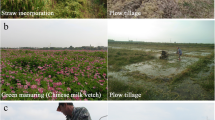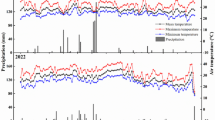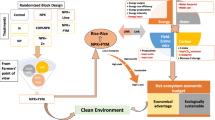Abstract
Rice–crayfish farming systems (RCs), a novel rice cropping system, have gained rapid popularity in many countries due to their economic advantages. Fertilizers tend to be applied in large quantities for higher profits, but has high burden on resources and environment, especially in terms of the carbon emissions. It is crucial to explore an optimal fertilization strategy with high productivity and low carbon emissions for the sustainable development of RCs. However, information about C emissions is incomplete, regarding the indirect C emissions during the rice growing season as well as C emissions during the crayfish culture period. We conducted field experiments to investigate the effects of five fertilization strategies including no fertilization (CK), farmer’s practices (FP), optimized fertilization (OPT), organic fertilization only (OF), and organic fertilizer substitution (OPTOF) on the productivity, economic benefits, greenhouse gas (GHG) emissions, carbon footprint, and sustainability index of RCs. Results showed that OPT reduced direct (by 6.7%) and indirect (by 37.0%) GHG emissions during the rice growing season while maintaining rice (95%) and crayfish (104%) yields compared with that of FP. Additionally, the soil organic carbon storage and annual economic benefit of the OPT increased by 20.1% and 4.7%, respectively, whereas the carbon footprints of unit area, unit grain yield, unit energy yield, and unit of economic output decreased by 29.5%, 27.2%, 24.5%, and 32.7%, compared to the FP, respectively. The sustainability index (0.78) of the OPT treatment was significantly higher than that of other treatments due to its higher productivity and lower the carbon footprint. In conclusion, optimal fertilization strategy in RCs could achieve to increase productivity while reducing carbon footprint. This is conducive to the sustainability of RCs. Future attention in RCs should be focused on the development and promotion of such strategies.







Similar content being viewed by others
Data availability
The authors confrm that the data supporting the fndings of this study are available within the article. Further raw data is available from the corresponding author, upon reasonable request.
Code availability
Not applicable.
Reference
Argento F, Liebisch F, Anken T, Walter A, El Benni N (2022) Investigating two solutions to balance revenues and N surplus in swiss winter wheat. Agr Syst 201:103451. https://doi.org/10.1016/j.agsy.2022.103451
Bargaz A, Lyamlouli K, Chtouki M, Zeroual Y, Dhiba D (2018) Soil microbial resources for improving fertilizers efficiency in an integrated plant nutrient management system. Front Microbiol 9:1606. https://doi.org/10.3389/fmicb.2018.01606
Bennett AJ, Bending GD, Chandler D, Hilton S, Mills P (2012) Meeting the demand for crop production: the challenge of yield decline in crops grown in short rotations. Biol Rev 87:52–71. https://doi.org/10.1111/j.1469-185X.2011.00184.x
Cassman KG, Grassini P (2020) A global perspective on sustainable intensification research. Nat Sustain 3:262–268. https://doi.org/10.1038/s41893-020-0507-8
Chai Q, Qin AZ, Gan YT, Yu AZ (2014) Higher yield and lower carbon emission by intercropping maize with rape, pea, and wheat in arid irrigation areas. Agron Sustain Dev 34:535–543. https://doi.org/10.1007/s13593-013-0161-x
Chai Q, Nemecek T, Liang C, Zhao C, Yu AZ, Coulter JA, Wang YF, Hu FL, Wang L, Siddique KHM, Gan YT (2021) Integrated farming with intercropping increases food production while reducing environmental footprint. P Natl Acad Sci USA 118(38):e2106382118. https://doi.org/10.1073/pnas.2106382118
Chen Z, Lin S, Yao ZS, Zheng XH, Gschwendtner S, Schloter M, Liu MJ, Zhang YN, Butterbach-Bahl K, Dannenmann M (2018) Enhanced nitrogen cycling and N2O loss in water-saving ground cover rice production systems (GCRPS). Soil Biol Biochem 121:77–86. https://doi.org/10.1016/j.soilbio.2018.02.015
Chen PF, Yang JP, Jiang ZH, Zhu EY, Mo CY (2020) Prediction of future carbon footprint and ecosystem service value of carbon sequestration response to nitrogen fertilizer rates in rice production. Sci Total Environ 735:139506. https://doi.org/10.1016/j.scitotenv.2020.139506
Chen ZX, Tu XS, Meng H, Chen C, Chen YJ, Elrys AS, Cheng Y, Zhang JB, Cai ZC (2021) Microbial process-oriented understanding of stimulation of soil N2O emission following the input of organic materials. Environ Pollut 284:117176. https://doi.org/10.1016/j.envpol.2021.117176
Chen YL, Du ZL, Weng Z, Sun K, Zhang YQ, Liu Q, Yang Y, Li Y, Wang ZB, Luo Y, Gao B, Chen B, Pan ZZ, Van Zwieten L (2023) Formation of soil organic carbon pool is regulated by the structure of dissolved organic matter and microbial carbon pump efficacy: a decadal study comparing different carbon management strategies. Global Change Biol 29:5445–5459. https://doi.org/10.1111/gcb.16865
Fan CH, Zhang W, Chen X, Li N, Li W, Wang Q, Duan PP, Chen M (2021) Residual effects of four-year amendments of organic material on N2O production driven by ammonia-oxidizing archaea and bacteria in a tropical vegetable soil. Sci Total Environ 781:146746. https://doi.org/10.1016/j.scitotenv.2021.146746
Fang K, Gao H, Sha Z, Dai W, Cao L (2021) Mitigating global warming potential with increase net ecosystem economic budget by integrated rice-frog farming in eastern China. Agr Ecosyst Environ 308:107235. https://doi.org/10.1016/j.agee.2020.107235
Fang YT, Ren T, Zhang ST, Liu Y, Liao SP, Li XK, Cong RH, Lu JW (2021) Rotation with oilseed rape as the winter crop enhances rice yield and improves soil indigenous nutrient supply. Soil Till Res 212:105065. https://doi.org/10.1016/j.still.2021.105065
Fang XT, Wang C, Xiao SQ, Yu K, Zhao JT, Liu SW, Zou JW (2023) Lower methane and nitrous oxide emissions from rice aquaculture coculture systems than from rice paddies in Southeast China. Agr Forest Meteorol 338:109540. https://doi.org/10.1016/j.agrformet.2023.109540
Gou ZW, Yin W, Asibi AE, Fan ZL, Chai Q, Cao WD (2022) Improving the sustainability of cropping systems via diversified planting in arid irrigation areas. Agron Sustain Dev 42:88. https://doi.org/10.1007/s13593-022-00823-2
Guo L, Zhao LF, Ye JL, Ji ZJ, Tang JJ, Bai KY, Zheng SJ, Hu LL, Chen X (2022) Using aquatic animals as partners to increase yield and maintain soil nitrogen in the paddy ecosystems. Elife 11:e73869. https://doi.org/10.7554/eLife.73869
Hou J, Wang X, Xu Q, Cao Y, Zhu J (2021) Rice-crayfish systems are not a panacea for sustaining cleaner food production. Environ Sci Pollut R 28:22913–22916. https://doi.org/10.1007/s11356-021-12345-7
Hu NJ, Liu CH, Chen Q, Zhu LQ (2021) Life cycle environmental impact assessment of rice-crayfish integrated system: a case study. J Clean Prod 280:124440. https://doi.org/10.1016/j.jclepro.2020.124440
Huang JX, Chen YQ, Pan J, Liu WR, Yang GL, Xiao XP, Zheng HB, Tang WG, Tang HM, Zhou LJ (2019) Carbon footprint of different agricultural systems in China estimated by different evaluation metrics. J Clean Prod 225:939–948. https://doi.org/10.1016/j.jclepro.2019.04.044
Jiang Y, Cao CG (2021) Crayfish-rice integrated system of production: an agriculture success story in China a review. Agron Sustain Dev 41:68. https://doi.org/10.1007/s13593-021-00724-w
Jiang ZH, Zhong YM, Yang JP, Wu YXY, Li H, Zheng L (2019) Effect of nitrogen fertilizer rates on carbon footprint and ecosystem service of carbon sequestration in rice production. Sci Total Environ 670:210–217. https://doi.org/10.1016/j.scitotenv.2019.03.188
Li SH, Guo LJ, Cao CG, Li CF (2021) Effects of straw returning levels on carbon footprint and net ecosystem economic benefits from rice-wheat rotation in Central China. Environ Sci Pollut R 28:5742–5754. https://doi.org/10.1007/s11356-020-10914-w
Li XX, Cao J, Huang JL, Xing DY, Peng SB (2021) Effects of topsoil removal on nitrogen uptake, biomass accumulation, and yield formation in puddled-transplanted rice. Field Crop Res 265:108130. https://doi.org/10.1016/j.fcr.2021.108130
Li P, Wu GG, Li YJ, Hu C, Ge L, Zheng XQ, Zhang JQ, Chen J, Zhang HL, Bai NL, Zhang HY, Song LL, Sun Y, Jiang W, Jia JW, Chen YF, Wang C, Lv BB, Wu X, Pan AH, Li SX, Lv WG (2022) Long-term rice-crayfish-turtle co-culture maintains high crop yields by improving soil health and increasing soil microbial community stability. Geoderma 413:115745. https://doi.org/10.1016/j.geoderma.2022.115745
Li FB, Qian HY, Yang T, Wang MJ, Fang FP, Jiang Y, Wu DX, Zhang N, Feng JF (2023) Higher food yields and lower greenhouse gas emissions from aquaculture ponds with high-stalk Rice planted. Environ Sci Technol 57:12270–12279. https://doi.org/10.1021/acs.est.3c02667
Li YF, Wu TY, Wang SD, Ku XC, Zhong ZM, Liu HY, Li JL (2023b) Developing integrated rice-animal farming based on climate and farmers choices. Agr Syst 204(2023):103554. https://doi.org/10.1016/j.agsy.2022.103554
Linquist BA, Adviento-Borbe MA, Pittelkow CM, van Kessel C, van Groenigen KJ (2012) Fertilizer management practices and greenhouse gas emissions from rice systems: a quantitative review and analysis. Field Crop Res 135:10–21. https://doi.org/10.1016/j.fcr.2012.06.007
Liu TQ, Li CF, Tan WF, Wang JP, Feng JH, Hu QY, Cao CG (2022) Rice-crayfish co-culture reduces ammonia volatilization and increases rice nitrogen uptake in Central China. Agr Ecosyst Environ 330:107869. https://doi.org/10.1016/j.agee.2022.107869
Maillard E, Angers DA (2014) Animal manure application and soil organic carbon stocks: a meta-analysis. Global Change Biol 20:666–679. https://doi.org/10.1111/gcb.12438
Mi WH, Sun Y, Xia SQ, Zhao HT, Mi WT, Brookes PC, Liu YL, Wu LH (2018) Effect of inorganic fertilizers with organic amendments on soil chemical properties and rice yield in a low-productivity paddy soil. Geoderma 320:23–29. https://doi.org/10.1016/j.geoderma.2018.01.016
Moe K, Moh SM, Htwe AZ, Kasihara Y, Yamakawa T (2019) Effects of integrated organic and inorganic fertilizers on yield and growth parameters of Rice varieties. Rice Sci 26:309–318. https://doi.org/10.1016/j.rsci.2019.08.005
Monjardino M, Loi A, Thomas DT, Revell CK, Flohr BM, Llewellyn RS, Norman HC (2022) Improved legume pastures increase economic value, resilience and sustainability of crop-livestock systems. Agr Syst 203(2022):103519. https://doi.org/10.1016/j.agsy.2022.103519
Musafiri CM, Macharia JM, Kiboi MN, Ng’etich OK, Shisanya CA, Okeyo JM, Mugendi DN, Okwuosa EA, Ngetich FK (2020) Soil greenhouse gas fluxes from maize cropping system under different soil fertility management technologies in Kenya. Agr Ecosyst Environ 301:107064. https://doi.org/10.1016/j.agee.2020.107064
Pan GX, Li LQ, Wu LS, Zhang XH (2004) Storage and sequestration potential of topsoil organic carbon in China’s paddy soils. Global Change Biol 10:79–92. https://doi.org/10.1111/j.1365-2486.2003.00717.x
Pei Y, Chen XW, Niu ZH, Su XJ, Wang YY, Wang XL (2023) Effects of nitrogen fertilizer substitution by cow manure on yield, net GHG emissions, carbon and nitrogen footprints in sweet maize farmland in the Pearl River Delta in China. J Clean Prod 399:136676. https://doi.org/10.1016/j.jclepro.2023.136676
Qaswar M, Jing H, Ahmed W, Li DC, Liu SJ, Lu Z, Cai AD, Liu LS, Xu YM, Gao JS, Zhang HM (2020) Yield sustainability, soil organic carbon sequestration and nutrients balance under long-term combined application of manure and inorganic fertilizers in acidic paddy soil. Soil Till Res 198:104569. https://doi.org/10.1016/j.still.2019.104569
Ren FL, Misselbrook TH, Sun N, Zhang XB, Zhang SX, Jiao JH, Xu MG, Wu L (2021) Spatial changes and driving variables of topsoil organic carbon stocks in chinese croplands under different fertilization strategies. Sci Total Environ 767:144350. https://doi.org/10.1016/j.scitotenv.2020.144350
Shang QY, Yang XX, Gao CM, Wu PP, Liu JJ, Xu YC, Shen QR, Zou JW, Guo SW (2011) Net annual global warming potential and greenhouse gas intensity in chinese double rice-cropping systems: a 3-year field measurement in long-term fertilizer experiments. Global Change Biol 17:2196–2210. https://doi.org/10.1111/j.1365-2486.2010.02374.x
Shen JL, Tang H, Liu JY, Wang C, Li Y, Ge TD, Jones DL, Wu JS (2014) Contrasting effects of straw and straw-derived biochar amendments on greenhouse gas emissions within double rice cropping systems. Agr Ecosyst Environ 188:264–274. https://doi.org/10.1016/j.agee.2014.03.002
Sheng F, Cao CG, Li CF (2018) Integrated rice-duck farming decreases global warming potential and increases net ecosystem economic budget in Central China. Environ Sci Pollut R 25:22744–22753. https://doi.org/10.1007/s11356-018-2380-9
Spohn M, Klaus K, Wanek W, Richter A (2016) Microbial carbon use efficiency and biomass turnover times depending on soil depth - implications for carbon cycling. Soil Biol Biochem 96:74–81. https://doi.org/10.1016/j.soilbio.2016.01.016
Sui BA, Feng XM, Tian GL, Hu XY, Shen QR, Guo SW (2013) Optimizing nitrogen supply increases rice yield and nitrogen use efficiency by regulating yield formation factors. Field Crop Res 150:99–107. https://doi.org/10.1016/j.fcr.2013.06.012
Sun ZC, Guo Y, Li CF, Cao CG, Yuan PL, Zou FL, Wang JH, Jia PA, Wang JP (2019) Effects of straw returning and feeding on greenhouse gas emissions from integrated rice-crayfish farming in jianghan plain. China. Environ Sci Pollut R 26(12):11710–11718. https://doi.org/10.1007/s11356-019-04572-w
Sun G, Sun M, Du LS, Zhang Z, Wang ZC, Zhang GB, Nie SA, Xu HQ, Wang H (2021) Ecological rice-cropping systems mitigate global warming-a meta-analysis. Sci Total Environ 789:147900. https://doi.org/10.1016/j.scitotenv.2021.147900
Sun T, Feng XM, Lal R, Cao TH, Guo JR, Deng AX, Zheng CY, Zhang J, Song ZW, Zhang WJ (2021) Crop diversification practice faces a tradeoff between increasing productivity and reducing carbon footprints. Agr Ecosyst Environ 321:107614. https://doi.org/10.1016/j.agee.2021.107614
Wang J, Zhu B, Zhang JB, Muller C, Cai ZC (2015) Mechanisms of soil N dynamics following long-term application of organic fertilizers to subtropical rain-fed purple soil in China. Soil Biol Biochem 91:222–231. https://doi.org/10.1016/j.soilbio.2015.08.039
Wang XL, Chen Y, Yang KP, Duan FY, Liu P, Wang ZG, Wang JW (2021) Effects of legume intercropping and nitrogen input on net greenhouse gas balances, intensity, carbon footprint and crop productivity in sweet maize cropland in South China. J Clean Prod 314:127997. https://doi.org/10.1016/j.jclepro.2021.127997
Wang C, Ma XF, Shen JL, Chen D, Zheng L, Ge TD, Li Y, Wu JS (2022) Reduction in net greenhouse gas emissions through a combination of pig manure and reduced inorganic fertilizer application in a double-rice cropping system: three-year results. Agr Ecosyst Environ 326:107799. https://doi.org/10.1016/j.agee.2021.107799
Wright LA, Kemp S, Williams I (2011) ‘Carbon footprinting’: towards a universally accepted definition. Carbon Manag 2:61–72. https://doi.org/10.4155/Cmt.10.39
Xia LL, Lam SK, Yan XY, Chen DL (2017) How does recycling of livestock manure in agroecosystems affect crop productivity, reactive nitrogen losses, and soil carbon balance. Environ Sci Technol 51:7450–7457. https://doi.org/10.1021/acs.est.6b06470
Xu Q, Liu T, Guo HL, Duo Z, Gao H, Zhang HC (2021) Conversion from rice-wheat rotation to rice-crayfish coculture increases net ecosystem service values in hung-tse Lake area, East China. J Clean Prod 319:128883. https://doi.org/10.1016/j.jclepro.2021.128883
Xu Q, Peng X, Guo HL, Che Y, Dou Z, Xing ZP, Hou J, Styles D, Gao H, Zhang HC (2022) Rice-crayfish coculture delivers more nutrition at a lower environmental cost. Sustain Prod Consump 29:14–24. https://doi.org/10.1016/j.spc.2021.09.020
Xu Q, Dai LX, Shang ZY, Zhou Y, Li JY, Dou Z, Yuan XC, Gao H (2023) Application of controlled-release urea to maintain rice yield and mitigate greenhouse gas emissions of rice-crayfish coculture field. Agr Ecosyst Environ 344:108312. https://doi.org/10.1016/j.agee.2022.108312
Yu HY, Zhang XC, Shen WY, Yao HY, Meng XT, Zeng JY, Zhang GB, Zamanien K (2023) A meta-analysis of ecological functions and economic benefits of co-culture models in paddy fields. Agr Ecosyst Environ 341:108195. https://doi.org/10.1016/j.agee.2022.108195
Yuan S, Linquist BA, Wilson LT, Cassman KG, Stuart AM, Pede V, Miro B, Saito K, Agustiani N, Aristya VE, Krisnadi LY, Zanon AJ, Heinemann AB, Carracelas G, Subash N, Brahmanand PS, Li T, Peng SB, Grassini P (2021) Sustainable intensification for a larger global rice bowl. Nat Commun 12:7163. https://doi.org/10.1038/s41467-021-27424-z
Yuan PL, Li XH, Ni ML, Cao CG, Jiang LG, Iqbal A, Wang JP (2022) Effects of straw return and feed addition on the environment and nitrogen use efficiency under different nitrogen application rates in the rice-crayfish system. Plant Soil 475:411–426. https://doi.org/10.1007/s11104-022-05376-7
Zhang D, Wang HY, Pan JT, Luo JF, Liu J, Gu BJ, Liu S, Zhai LM, Lindsey S, Zhang YT, Lei QL, Wu SX, Smith P, Liu HB (2018) Nitrogen application rates need to be reduced for half of the rice paddy fields in China. Agr Ecosyst Environ 265:8–14. https://doi.org/10.1016/j.agee.2018.05.023
Zhang M, Yao YL, Tian YH, Ceng K, Zhao M, Zhao M, Yin B (2018) Increasing yield and N use efficiency with organic fertilizer in chinese intensive rice cropping systems. Field Crop Res 227:102–109. https://doi.org/10.1016/j.fcr.2018.08.010
Zhang XY, Fang QC, Zhang T, Ma WQ, Velthof GL, Hou Y, Oenema O, Zhang FS (2020) Benefits and trade-offs of replacing synthetic fertilizers by animal manures in crop production in China: a meta-analysis. Global Change Biol 26:888–900. https://doi.org/10.1111/gcb.14826
Zhang Z, Du LS, Xiao ZY, Li CW, Wang ZC, Zhou PY, Sun G, Ye YY, Hu T, Wang H (2022) Rice-crayfish farming increases soil organic carbon. Agr Ecosyst Environ 329:107857. https://doi.org/10.1016/j.agee.2022.107857
Zhang WY, Xu MS, Lu JW, Ren T, Cong RH, Lu ZF, Li XK (2023) Integrated rice-aquatic animals culture systems promote the sustainable development of agriculture by improving soil fertility and reducing greenhouse gas emissions. Field Crop Res 299:108970. https://doi.org/10.1016/j.fcr.2023.108970
Zhong C, Liu Y, Xu XT, Yang BJ, Aamer M, Zhang P, Huang GQ (2021) Paddy-upland rotation with chinese milk vetch incorporation reduced the global warming potential and greenhouse gas emissions intensity of double rice cropping system. Environ Pollut 276:116696. https://doi.org/10.1016/j.envpol.2021.116696
Funding
This work was financially supported by the Major project of Hubei Hongshan Laboratory (2121hsz002).
Author information
Authors and Affiliations
Contributions
Wanyang Zhang: Data curation, Formal analysis, Paper draft writing. Mingshuang Xu: Methodology, Investigation. Tianqiao Ma: Methodology, Investigation. Jianwei Lu: Conceptualization. Jun Zhu: Review and editing. Xiaokun Li: Project administration, Supervision, reviewing.
Corresponding author
Ethics declarations
Conflict of interest
The author declare to have no competing interests.
Ethical approval
Not applicable.
Consent for publication and participation
All the authors whose names appeared on the submission approved the version to be published and agreed to be accountable for all aspects of the work in ensuring that the questions related to the accuracy of the integrity of any part of the work were appropriately investigated and resolved.
Additional information
Publisher's Note
Springer Nature remains neutral with regard to jurisdictional claims in published maps and institutional affiliations.
Supplementary Information
Below is the link to the electronic supplementary material.
About this article
Cite this article
Zhang, W., Xu, M., Ma, T. et al. Optimal fertilization strategy promotes the sustainability of rice–crayfish farming systems by improving productivity and decreasing carbon footprint. Agron. Sustain. Dev. 44, 32 (2024). https://doi.org/10.1007/s13593-024-00952-w
Accepted:
Published:
DOI: https://doi.org/10.1007/s13593-024-00952-w




